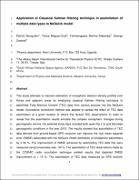| dc.contributor.author | Mungufeni, Patrick | |
| dc.contributor.author | Migoya-Orué, Yenca | |
| dc.contributor.author | Matamba, Tshimangadzo Merline | |
| dc.contributor.author | Omondi, George | |
| dc.date.accessioned | 2022-03-22T07:56:41Z | |
| dc.date.available | 2022-03-22T07:56:41Z | |
| dc.date.issued | 2022-03-03 | |
| dc.identifier.citation | Mungufeni, P., Migoya-Orué, Y., Matamba, T. M., Omondi, G. (2022). Application of Classical Kalman filtering technique in assimilation of multiple data types to NeQuick model. Journal of Space Weather and Space Climate. | en_US |
| dc.identifier.issn | 2115-7251 | |
| dc.identifier.uri | http://dir.muni.ac.ug/xmlui/handle/20.500.12260/449 | |
| dc.description.abstract | This study attempts to improve estimation of ionospheric electron density profiles over Korea and adjacent areas by employing classical Kalman filtering technique to assimilate Total Electron Content (TEC) data from various sources into the NeQuick model. Successive corrections method was applied to spread the effect of TEC data assimilation at a given location to others that lacked TEC observations. In order to reveal that the assimilation results emulate the complex ionospheric changes during geomagnetic storms, the selected study days included both quiet (Kp ≤ 3) and disturbed geomagnetic conditions in the year 2015. The results showed that assimilation of TEC data derived from ground-based GPS receivers can improve the root mean squared error (RMSE) associated with the NeQuick model estimation of ionospheric parameters by ≥ 56 %. The improvement of RMSE achieved by assimilating TEC data that were measured using ionosondes was ~50 %. The assimilation of TEC observations made by the COSMIC radio occultation technique yielded results that depicted RMSE improvement of > 10 %. The assimilation of TEC data measured by GPS receiver onboard Low Earth Orbiting satellites yielded results that revealed 1 deterioration of RMSE. This outcome might be due to either the fact that the receivers are on moving platforms and these dynamics might have not been accounted for during TEC computation or limitation of the assimilation process. Validation of our assimilation results with global ionosphere TEC data maps as processed at the center for orbit determination in Europe (CODE) revealed that both depicted similar TEC changes, showing response to a geomagnetic storm. | en_US |
| dc.publisher | EDP Sciences | en_US |
| dc.subject | Ionosphere | en_US |
| dc.subject | Modeling | en_US |
| dc.subject | Data assimilation | en_US |
| dc.subject | NeQuick | en_US |
| dc.subject | Geomagnetic storms | en_US |
| dc.title | Application of Classical Kalman filtering technique in assimilation of multiple data types to NeQuick model | en_US |
| dc.type | Article | en_US |

